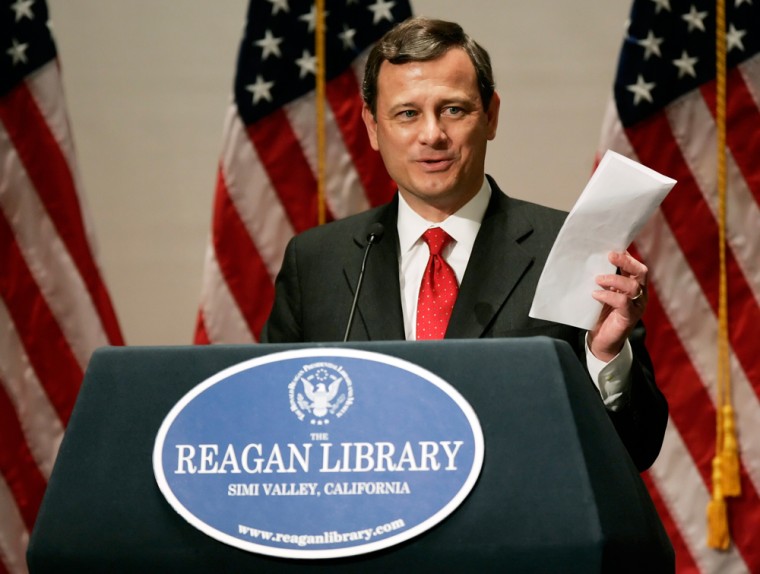Many Supreme Court justices prize the anonymity that comes with their lifetime appointments and camera-free courtroom. Unrecognized, justices have snapped pictures for tourists in front of the court or been asked to move out of the way of a shot.
On rare occasion, a justice might consent to an interview on the C-SPAN cable network to discuss a recent book or be shown addressing a lawyers’ gathering somewhere.
Lately, however, some members of the court have been popping up in unusual places — including network television news programs — and talking about more than just the law.
For an institution that has kept the media at a comfortable distance for much of its existence, the Supreme Court’s increasingly public face is astonishing, said University of Chicago law professor Dennis Hutchinson, who served as a law clerk for Justices Byron White and William Douglas.
“More and more, the justices are spending time talking off the bench informally to reporters, on the record, off the record, in public, on tape, on film,” Hutchinson said.
Justices Antonin Scalia and Stephen Breyer recently debated their competing views of the Constitution. Breyer and retired Justice Sandra Day O’Connor have talked publicly and repeatedly about threats to judicial independence. Justice Samuel Alito proudly affirmed his membership in the conservative Federalist Society, speaking in a packed ballroom at its recent convention.
‘A smiley face in the center chair’
Perhaps most noteworthy, though, has been the media-friendly attitude adopted by new Chief Justice John Roberts, in contrast to his predecessor William Rehnquist. Roberts recently was featured on ABC News’ “Nightline” discussing both his view of the court and his son Jack’s Spiderman imitation at Roberts’ introduction by President Bush.
“Roberts is putting a smiley face in the center chair,” said Hutchinson, who recalled earlier eras in which chief justices rigorously avoided the press and looked askance at their colleagues who consented to the rare interview.
Having spent more of his legal career as an advocate than as a judge, Roberts is at ease on a public stage. He has longstanding professional relationships with many in the court’s veteran reporting corps.
For many years, justices held to the view that the court’s mystique and reputation were enhanced by their distance from the public. The justices spoke through their written opinions, laying out not only what they had decided, but why.
Their unbending refusal to allow cameras in the courtroom has been part and parcel of this belief that the Supreme Court is unlike the Congress and the presidency in that it does not serve at the pleasure of voters.
Rehnquist could stroll around the court, unrecognized by tourists. Justice Anthony Kennedy snapped a photograph for visitors who had no idea who he was. Justice John Paul Stevens once was asked to move out of the way by a picture-taking tourist.
Adjusting to the ‘burden of explanation’
Now comes Roberts, who appears intent on allowing the public more of a look inside the court, although the prospect of televised court sessions still seems remote. He also heartily endorsed tighter ethics rules for judges, although those rules do not apply to the Supreme Court.
Douglas Kmiec, a Pepperdine law professor and Justice Department official in earlier Republican administrations, said Roberts’ public relations effort is in line with his desire to have the court issue narrower, more consensual rulings.
“I think he feels a burden of explanation. The court has become so much the storm center of cultural controversy. Roberts is committed to not having that be so,” Kmiec said. “If that’s the case, it requires a certain amount of public explanation.”
Stephen Wermiel, a law professor at American University, agreed that “the idea of more consensus brought about by narrower decision making enhances the public image of the court.”
Yet Breyer and Scalia, for instance, have said they don’t necessarily agree with the chief’s call for greater consensus on the court. Scalia made clear he prefers bold rulings that serve as a guide for lower courts and lawyers, saying narrow rulings can be so constricted as to be useless
Another possibility, said University of Virginia law professor G. Edward White, is that the court will stay in the middle of national controversies and that Roberts believes its credibility will be enhanced if the justices appear less remote.
It may also be that the justices believe they can keep proponents of even greater openness, especially cameras in the courtroom, at bay.
At this early stage in his tenure, it is unclear just where the court is headed. With Roberts and Alito two new conservative faces on the court, high-profile cases involving abortion, race and the environment await decisions.
But by courting the media, the chief justice already has broken with his predecessors in one respect.
